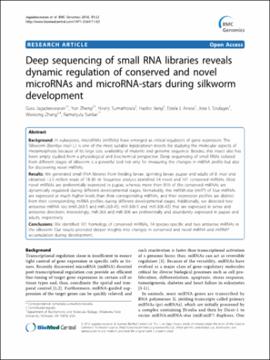| dc.contributor.author | Jagadeeswaran, Guru | |
| dc.contributor.author | Zheng, Yun | |
| dc.contributor.author | Sumathipala, Niranji | |
| dc.contributor.author | Jiang, Haobo | |
| dc.contributor.author | Arrese, Estela L. | |
| dc.contributor.author | Soulages, Jose L. | |
| dc.contributor.author | Zhang, Weixiong | |
| dc.contributor.author | Sunkar, Ramanjulu | |
| dc.date.accessioned | 2018-11-09T21:10:45Z | |
| dc.date.available | 2018-11-09T21:10:45Z | |
| dc.date.issued | 2010-01-20 | |
| dc.identifier | oksd_jagadeeswaran_deepsequencingo_2010 | |
| dc.identifier.citation | Jagadeeswaran, G., Zheng, Y., Sumathipala, N., Jiang, H., Arrese, E. L., Soulages, J. L., ... Sunkar, R. (2010). Deep sequencing of small RNA libraries reveals dynamic regulation of conserved and novel microRNAs and microRNA-stars during silkworm development. BMC Genomics, 11, Article 52. https://doi.org/10.1186/1471-2164-11-52 | |
| dc.identifier.uri | https://hdl.handle.net/11244/302051 | |
| dc.description.abstract | Background: In eukaryotes, microRNAs (miRNAs) have emerged as critical regulators of gene expression. The Silkworm (Bombyx mori L.) is one of the most suitable lepidopteran insects for studying the molecular aspects of metamorphosis because of its large size, availability of mutants and genome sequence. Besides, this insect also has been amply studied from a physiological and biochemical perspective. Deep sequencing of small RNAs isolated from different stages of silkworm is a powerful tool not only for measuring the changes in miRNA profile but also for discovering novel miRNAs. | |
| dc.description.abstract | Results: We generated small RNA libraries from feeding larvae, spinning larvae, pupae and adults of B. mori and obtained ~2.5 million reads of 18-30 nt. Sequence analysis identified 14 novel and 101 conserved miRNAs. Most novel miRNAs are preferentially expressed in pupae, whereas more than 95% of the conserved miRNAs are dynamically regulated during different developmental stages. Remarkably, the miRNA-star (miR*) of four miRNAs are expressed at much higher levels than their corresponding miRNAs, and their expression profiles are distinct from their corresponding miRNA profiles during different developmental stages. Additionally, we detected two antisense miRNA loci (miR-263-S and miR-263-AS; miR-306-S and miR-306-AS) that are expressed in sense and antisense directions. Interestingly, miR-263 and miR-306 are preferentially and abundantly expressed in pupae and adults, respectively. | |
| dc.description.abstract | Conclusions: We identified 101 homologs of conserved miRNAs, 14 species-specific and two antisense miRNAs in the silkworm. Our results provided deeper insights into changes in conserved and novel miRNA and miRNA* accumulation during development. | |
| dc.format | application/pdf | |
| dc.language | en_US | |
| dc.publisher | BioMed Central | |
| dc.rights | This material has been previously published. In the Oklahoma State University Library's institutional repository this version is made available through the open access principles and the terms of agreement/consent between the author(s) and the publisher. The permission policy on the use, reproduction or distribution of the material falls under fair use for educational, scholarship, and research purposes. Contact Digital Resources and Discovery Services at lib-dls@okstate.edu or 405-744-9161 for further information. | |
| dc.title | Deep sequencing of small RNA libraries reveals dynamic regulation of conserved and novel microRNAs and microRNA-stars during silkworm development | |
| osu.filename | oksd_jagadeeswaran_deepsequencingo_2010.pdf | |
| dc.description.peerreview | Peer reviewed | |
| dc.identifier.doi | 10.1186/1471-2164-11-52 | |
| dc.description.department | Biochemistry and Molecular Biology | |
| dc.description.department | Entomology and Plant Pathology | |
| dc.type.genre | Article | |
| dc.type.material | Text | |
| dc.subject.keywords | small RNAs | |
| dc.subject.keywords | juvenile hormone | |
| dc.subject.keywords | miRNA family | |
| dc.subject.keywords | pupal stage | |
| dc.subject.keywords | silk gland | |
